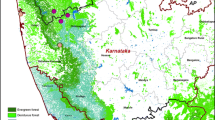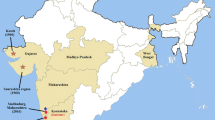Abstract
Kyasanur Forest Disease (KFD) is a viral haemorrhagic fever, transmitted to humans and other hosts by a tick vector of genus Haemaphysalis. It affects 400–500 people annually in the Western Ghats region of India through spring to summer season. To understand the species composition, distribution, and abundance of Haemaphysalis ticks in endemic taluks (sub-districts) of India, a surveillance for ticks was conducted between October 2017 and January 2018. In total 105 sites were selected based on grid sampling from five taluks representing five KFD endemic states in south India. A sum of 8373 ticks were collected by using standard flagging method. The study showed a wide distribution of host seeking tick species among the selected taluks, wherein Haemaphysalis spinigera was predominant in 3/5 taluks, Haemaphysalis bispinosa in 1/5 taluks, and both the species in 1/5 taluks. Further, the H. spinigera abundance was categorised and compared with the incidence of human cases during the same season. The grids with very high and high H. spinigera abundance had 70% of the 205 human cases reported. This method of tick surveillance could be efficiently used as a standard model for KFD transmission risk assessment and prediction of impending outbreaks.


Similar content being viewed by others
References
Ajesh K, Nagaraja BK, Sreejith K (2017) Kyasanur Forest Disease virus breaking the endemic barrier: an investigation into ecological effects on disease emergence and future outlook. Zoonoses Public Health 64:e73–e80. https://doi.org/10.1111/zph.12349
Anand MO, Krishnaswamy J, Kumar A, Bali A (2010) Sustaining biodiversity conservation in human-modified landscapes in the Western Ghats. Remnant Forests Matter Biol Conserv 143:2363–2374. https://doi.org/10.1016/j.biocon.2010.01.013
Banerjee K, Bhat HR (1977) Correlation between the number of persons suffering from Kyasanur Forest Disease and the intensity of infection in the tick population. Indian J Med Res 66:175–179
Bawa KS, Joseph G, Setty S (2007) Poverty, biodiversity and institutions in forest-agriculture ecotones in the Western Ghats and Eastern Himalaya ranges of India Agriculture. Ecosyst Env 121:287–295. https://doi.org/10.1016/j.agee.2006.12.023
Bhat HR, Naik SV (1978) Transmission of Kyasanur Forest Disease virus by Haemaphysalis wellingtoni Nuttall and Warburton, 1907 (Acarina: Ixodidae). Indian J Med Res 67:697–703
Bhat HR, Sreenivasan MA, Goverdhan MK, Naik SV (1975) Transmission of Kyasanur Forest Disease virus by Haemaphysalis kyasanurensis trapido, Hoogstraal and Rajagopalan, 1964 (Acarina: Ixodidae). Indian J Med Res 63:879–887
Clymer BC, Howell DE, Hair JA (1970) Environmental alteration in recreational areas by mechanical and chemical treatment as a means of lone star tick control. J Econ Entomol 63:504–509
Diuk-Wasser MA et al (2006) Spatiotemporal patterns of host-seeking Ixodes scapularis nymphs (Acari: Ixodidae) in the United States. J Med Entomol 43:166–176
Fish DaCH (1999) Methods used for creating a national Lymedisease risk map vol 48. Centers for Disease Control and Prevention, Atlanta
Geevarghese G, Mishra AC (2011) 2-Structurally primitive haemaphysalines. In: Haemaphysalis Ticks of India. Elsevier, London, pp 21–226. https://doi.org/10.1016/B978-0-12-387811-3.00002-4
Ghosh SN, Rajagopalan PK, Singh GK, Bhat HR (1975) Serological evidence of arbovirus activity in birds of KFD epizootic–epidemic area, Shimoga District, Karnataka, India. Indian J Med Res 63:1327–1334
Ghosh S et al (2007) Status of tick distribution in Bangladesh, India and Pakistan. Parasitol Res 101 Suppl 2:S207–S216 https://doi.org/10.1007/s00436-007-0684-7
Gunawardene N et al (2007) A brief overview of the Western Ghats—Sri Lanka biodiversity hotspot vol 93
Gurav YK et al (2018) Kyasanur Forest Disease prevalence in Western Ghats proven and confirmed by recent outbreak in Maharashtra, India, 2016 vector borne and zoonotic diseases 18:164–172. https://doi.org/10.1089/vbz.2017.2129
Hasle G (2013) Transport of ixodid ticks and tick-borne pathogens by migratory birds. Front Cell Infect Microbiol 3:48. https://doi.org/10.3389/fcimb.2013.00048
Kasabi GS, Murhekar MV, Sandhya VK, Raghunandan R, Kiran SK, Channabasappa GH, Mehendale SM (2013) Coverage and effectiveness of Kyasanur Forest Disease (KFD) vaccine in Karnataka, South India, 2005–10. PLoS Negl Trop Dis 7:e2025. https://doi.org/10.1371/journal.pntd.0002025
Kiran SK et al (2015) Kyasanur Forest Disease outbreak and vaccination strategy,Shimoga District, India, 2013–2014. Emerg Infect Dis 21:146–149. https://doi.org/10.3201/eid2101.141227
Mather TN, Nicholson MC, Donnelly EF, Matyas BT (1996) Entomologic index for human risk of Lyme disease. Am J Epidemiol 144:1066–1069
Mourya DTY (2016) Recent scenario of emergence of Kyasanur Forest Disease in India and public health importance. Curr Trop Med Rep 3:7–13. https://doi.org/10.1007/s40475-016-0067-1
Mourya DT et al (2012) Diagnosis of Kyasanur Forest Disease by nested RT-PCR, real-time RT-PCR and IgM capture ELISA. J Virol Methods 186:49–54. https://doi.org/10.1016/j.jviromet.2012.07.019
Mourya DT, Yadav PD, Patil DY (2014) Expediency of dengue illness classification: the Sri Lankan perspective Highly infectious tick-borne viral diseases: Kyasanur Forest Disease and Crimean-Congo haemorrhagic fever in India WHO South-East Asia. J Public Health 3:8–21. https://doi.org/10.4103/2224-3151.206890
Mourya DT, Sapkal GN, Yadav PD (2016) Difference in vector ticks dropping rhythm governs the epidemiology of Crimean-Congo haemorrhagic fever & Kyasanur Forest Disease in India. Indian J Med Res 144:633–635. https://doi.org/10.4103/0971-5916.200892
Pattnaik P (2006) Kyasanur forest Disease: an epidemiological view in India. Rev Med Virol 16:151–165. https://doi.org/10.1002/rmv.495
Pavri KM, Singh KR (1968) Kyasanur Forest Disease Virus infection in the frugivorous bat, Cynopterus sphinx. Indian J Med Res 56:1202–1204
Rajagopalan PK, Paul SD, Sreenivasan MA (1969a) Involvement of Rattus blanfordi (rodentia: Muridae) in the natural cycle of Kyasanur Forest Disease virus. Indian J Med Res 57:999–1002
Rajagopalan PK, Paul SD, Sreenivasan MA (1969b) Isolation of Kyasanur Forest Disease virus from the insectivorous bat, Rhinolophus rouxi and from Ornithodoros ticks. Indian J Med Res 57:805–808
Ramani KPaN (2007) Tick parasites of domestic animals of Kerala, South India Asian. J Anim Vet Adv 2:74–80. https://doi.org/10.3923/ajava.2007.74.80
Robbins DRG (2012) Tick-borne diseases: vector surveillance and control. Armed Forces Pest Management Board, Information Services Division, Silver spring
Sadanandane C, Elango A, Marja N, Sasidharan PV, Raju KHK, Jambulingam P (2017) An outbreak of Kyasanur Forest Disease in the Wayanad and Malappuram districts of Kerala, India. Ticks Tick-borne Dis 8:25–30 https://doi.org/10.1016/j.ttbdis.2016.09.010
Sadanandane C, Gokhale MD, Elango A, Yadav P, Mourya DT, Jambulingam P (2018) Prevalence and spatial distribution of Ixodid tick populations in the forest fringes of Western Ghats reported with human cases of Kyasanur Forest Disease and monkey deaths in South India. Exp Appl Acarol 75:135–142. https://doi.org/10.1007/s10493-018-0223-5
Singh KR, Pavri K, Anderson CR (1963) Experimental transovarial transmission of Kyasanur Forest Disease virus in Haemaphysalis spinigera. Nature 199:513
Singh KR, Pavri KM, Anderson CR (1964) Transmission of Kyasanur Forest Disease virus by Haemaphysalis turturis, Haemaphysalis papuana kinneari, Haemaphysalis minuta. Indian J Med Res 52:566–573
Sreenivasan MA, Rajagopalan PK, Bhat HR (1983) Spatial distribution of infected Haemaphysalis nymphs in the epizootic localities of Kyasanur Forest Disease. Indian J Med Res 78:531–536
Sreenivasan MA, Bhat HR, Rajagopalan PK (1986) The epizootics of Kyasanur Forest Disease in wild monkeys during 1964 to 1973. Trans R Soc Trop Med Hyg 80:810–814
Trapido H, Rajagopalan PK, Work TH, Varma MG (1959) Kyasanur Forest Disease. VIII. Isolation of Kyasanur Forest Disease virus from naturally infected ticks of the genus Haemaphysalis. Indian J Med Res 47:133–138
Trapido H, Goverdhan MK, Rajagopalan PK, Rebello MJ (1964) Ticks ectoparasitic on monkeys in the Kyasanur Forest Disease area of Shimoga district, Mysore State, India. Am J Trop Med Hyg 13:763–772
Trapido H, Varma MGR, Rajagopalan PK, Singh KRP, Rebello MJ (2009) A guide to the identification of all stages of the Haemaphysalis ticks of South India. Bull Entomol Res 55:249–270. https://doi.org/10.1017/S0007485300049439
Varma MG, Webb HE, Pavri KM (1960) Studies on the transmission of Kyasanur Forest Disease virus by Haemaphysalis spinigera Newman. Trans R Soc Trop Med Hyg 54:509–516
Acknowledgements
Authors acknowledge their sincere gratitude to all the state and district Government health officials of Wayanad in Kerala, Nilgiris in Tamilnadu, Shimoga in Karnataka, North Goa in Goa and Sindhudurg in Maharashtra for their immense support in executing this study. We would also like to extend our gratitude for all the AFI Project Administrators, Site managers, Specialists, Research assistants, technicians and field support staffs for their support in this study.
Funding
This work was partially funded from AFI project under the Cooperative Agreement, Grant no U01GH001051, awarded to GA, Manipal Academy of Higher Education by Centers for Disease Control and Prevention (CDC), Atlanta, USA.
Author information
Authors and Affiliations
Contributions
Designed the study: NBN, AJ; performed the experiment: NBN, AJ, HKH, PP, ADH, SP, MS, NK, YB, SD and AMA; GIS and data analysis: HM; wrote the paper: NBN, PP and SP; Reviewed: GA and all work supervised: GA and JA. All authors have read and approve the final version of the manuscript.
Corresponding author
Ethics declarations
Conflict of interest
The authors declares that they have no conflict of interest.
Disclaimer
The views expressed in this manuscript are those of the authors and do not necessarily represent the official position of the Manipal Academy of Higher Education or the US Centers for Disease Control and Prevention.
Additional information
Publisher’s Note
Springer Nature remains neutral with regard to jurisdictional claims in published maps and institutional affiliations.
Rights and permissions
About this article
Cite this article
Naren Babu, N., Jayaram, A., Hemanth Kumar, H. et al. Spatial distribution of Haemaphysalis species ticks and human Kyasanur Forest Disease cases along the Western Ghats of India, 2017–2018. Exp Appl Acarol 77, 435–447 (2019). https://doi.org/10.1007/s10493-019-00345-9
Received:
Accepted:
Published:
Issue Date:
DOI: https://doi.org/10.1007/s10493-019-00345-9




